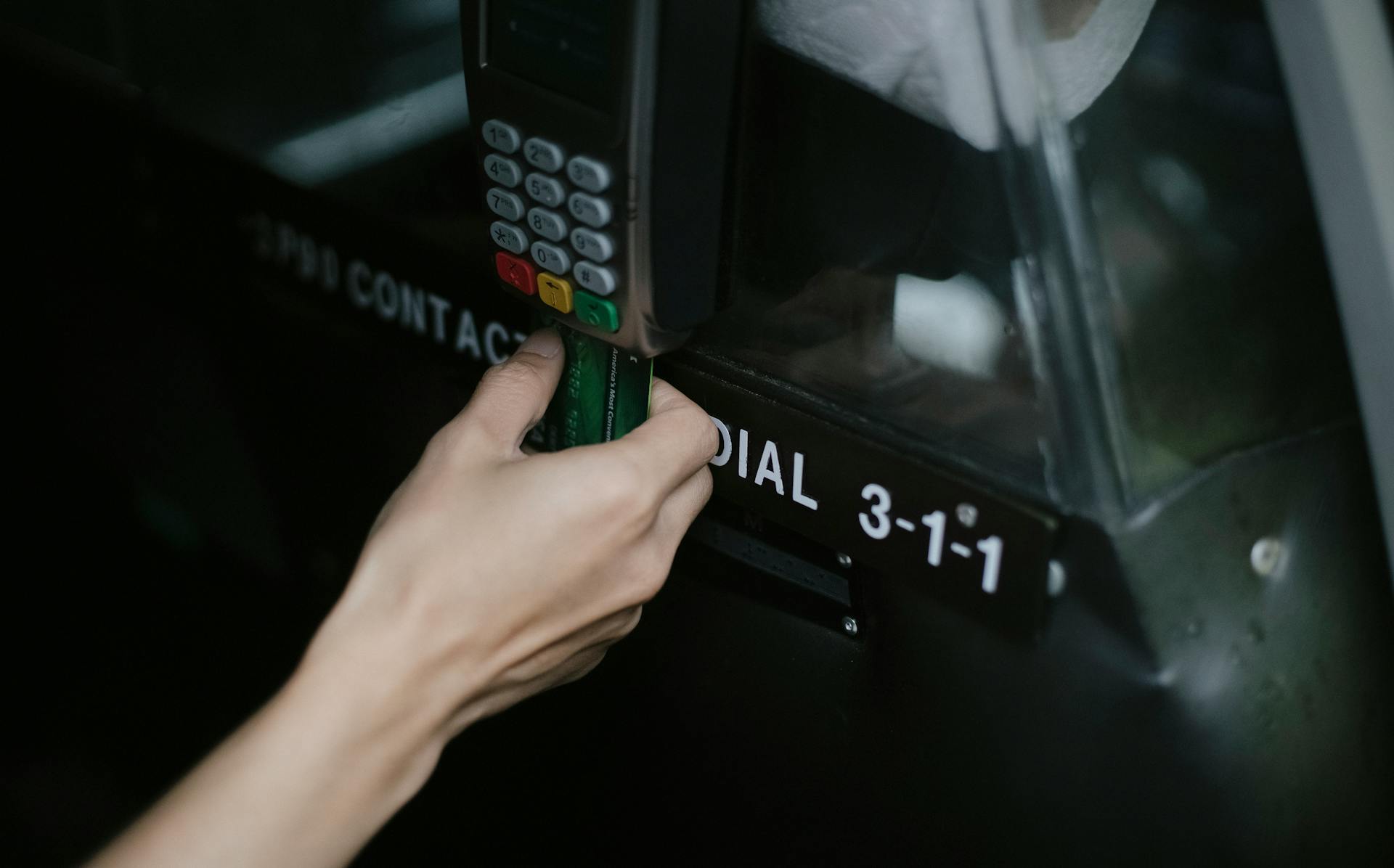
If you're like me, you've probably got a drawer or a box full of old credit cards that you're not sure what to do with. Many of these cards are no longer active, but some may still be collecting dust.
Old credit cards can be a security risk if they fall into the wrong hands. According to the article, a lost or stolen credit card can be used to make unauthorized purchases.
You can start by sorting through your old credit cards and identifying which ones are still active. If a card is still active, it's best to cut it up to prevent any potential fraud.
Consider canceling any inactive credit cards to avoid unnecessary fees and to help keep your credit report clean.
You might like: Does Paying off Old Credit Cards Help Score
Closing Accounts
Closing a credit account can lower your credit score, especially if it was one of your first credit cards. This is because the average length of your credit history makes up 15 percent of your FICO score.
Closing an account that's no longer in use can also affect your credit utilization ratio, which makes up 30 percent of your FICO score. This ratio is the amount of credit you use in relation to your credit limits.
If you close an account, you're reducing the amount of credit available to you, which could increase your utilization into a range that could cause your credit score to go down. Most experts suggest keeping your credit utilization below 30 percent for the best results.
Those with credit scores of 800 often keep their credit utilization at around 11 percent, according to FICO. This is a good example to aim for, as it shows that even those with excellent credit scores can keep their utilization low.
Closing an account with a steep annual fee can sometimes make financial sense, as you could be losing money every year you don't use the card. However, there are still more options worth considering first, depending on your situation.
Check this out: Is Credit Utilization Based on All Cards
How to Destroy

If you have a metal credit card, you'll need to take an alternative path to dispose of it. Call the number on the back of your card to request a prepaid envelope you can use to send it back to the issuer, who will then destroy it for you.
If you don't want to mail your card, you can also drop it off at a local bank branch for disposal. Keep in mind that they may not destroy metal credit cards themselves, but they'll know where to send them.
If you're looking for a more secure option, consider using a professional credit card destruction service like Shred-it. They implement best-in-class industry standards, including a secure chain of custody protocol that ensures your data is protected at every touchpoint.
Shred-it's process involves a barcode scan at every touchpoint, locked trucks and secure totes to keep information safe in transit, GPS-tracked fleets, and secure, monitored facilities to protect your information before it's destroyed.
A fresh viewpoint: How to Destroy Old Credit Cards with Chip
You can also destroy your old credit card at home using a few simple steps. First, run a magnet slowly along the card's strip to demagnetize it.
To further secure your card, smash the chip with a hammer to ensure your information cannot be stolen. Finally, cut the plastic card into different sized pieces.
Managing Accounts
Closing old credit accounts can lower your credit score, especially if it was one of your first credit cards.
Closing an account can affect your credit utilization ratio, making up 30 percent of your FICO score, and increase your utilization into a range that could cause your credit score to go down.
Most experts suggest keeping your credit utilization below 30 percent, which means no more than a $3,000 balance for every $10,000 in open revolving credit available to you.
You can access older accounts by looking at your credit reports, which you can get for free from AnnualCreditReport.com, and checking for accuracy overall.
You might like: How to Close All Credit Cards

Leaving an account dormant for too long may result in the issuer automatically closing the account.
You may need to update your new credit card information for any bills that are paid with your credit card, especially the expiration date and card verification value (CVV), after receiving a new card.
See what others are reading: Is It Bad to Open New Credit Cards
Request a Downgrade
If you're tired of paying an annual fee on your credit card, you may be able to request a downgrade to a no-fee option from the same issuer.
You can call your card issuer using the number on the back of your credit card to ask about your options.
Downgrading your credit card can be a simple and straightforward process if you know what to do.
Update Billing Information
Updating your billing information is a crucial step in managing your accounts. Payments can’t be processed with an expired card, and providers might cancel service or hit you with fees for missed or late payments.
If you're getting a new credit card, you'll need to update your card information for any bills that are paid with your credit card. The new card has a different expiration date and card verification value (CVV), so you'll need to provide the updated information.
Some issuers and merchants use an account updater service that automatically sends merchants any new card information. But it's always a good idea to check on expected recurring charges.
If you're a metal card holder, like those with the Chase Sapphire Preferred Card or Prime Visa, you can put your card issuer to work by calling the 800 number on the back of the card and initiating the process of sending the card back to the issuer.
Finding and Joining
If you're interested in joining the world of expired credit card collectors, you can start by looking into the American Credit Card Collectors Society. This group is dedicated to connecting collectors and providing resources for those interested in collecting old credit cards.
Older cards are generally worth more money, so if you have a stash of old credit cards, it might be worth exploring their value. Rare credit cards, especially those featuring celebrities or with special features, are also highly sought after.
If you're new to collecting expired credit cards, you might be wondering how to get started. The process of replacing an old card with a new one is a great place to begin, as it often involves getting rid of the old card.
You might enjoy: Old National Bank Credit Card
Finding Accounts
You can access your credit reports from all three credit bureaus - Experian, Equifax, and TransUnion - for free on AnnualCreditReport.com, with the option to get your reports once per week.
AnnualCreditReport.com is a great resource to start with because it allows you to check your credit reports from each bureau at no cost.
You can look over your credit reports to see if you have any old accounts you may have forgotten about.
Checking your credit reports can also help you ensure the accuracy of your credit information overall.
Just remember, leaving an account dormant for too long may result in the card issuer automatically closing the account.
Curious to learn more? Check out: Americanexpress Com Autopay
Join the Hobbyist Community

You can join the community of credit card collectors, who value expired cards for their rarity and condition. The American Credit Card Collectors Society is a great resource for connecting with like-minded enthusiasts.
Older cards are generally worth more money, especially if they're in excellent condition and have never been signed. Rare credit cards featuring a celebrity or with special features can be particularly valuable.
If you're looking to join the hobbyist community, you can start by checking out the American Credit Card Collectors Society's rules and guidelines. This will give you a sense of what makes a valuable credit card and how to get started with collecting.
Suggestion: Community Credit Union Credit Cards
Frequently Asked Questions
What are the old credit card companies' names?
The original names of Visa and Mastercard were BankAmericard and the Interbank Card Association, respectively. These names were changed to facilitate international growth and acceptance.
What credit cards were used in 1970?
In the early 1970s, most people held limited-use cards issued by retail firms, usable only in their stores. These cards were more common than bank-type credit cards at that time.
Sources
- https://www.bankrate.com/credit-cards/advice/what-to-do-with-an-old-or-expired-card/
- https://www.nerdwallet.com/article/credit-cards/credit-cards-expiration-dates
- https://www.shredit.ie/en-ie/blog/confidential-information-risk-management/how-to-destroy-old-credit-cards
- https://www.wikihow.com/Dispose-of-a-Credit-Card
- https://thepointsguy.com/credit-cards/5-tips-destroy-old-card/
Featured Images: pexels.com


